Kanban metrics allow you to measure and track the flow of work in a Kanban system to improve efficiency and predictability.
They capture key process indicators like cycle time, amount of work in progress (WIP), throughput, and flow efficiency.
Kanban metrics are applicable to any visual management system that relies on Kanban boards for facilitating workflow transparency and optimizing process performance.
With the right platform at hand, you can identify areas for improvement in a seamless way and monitor your progress toward achieving your goals.
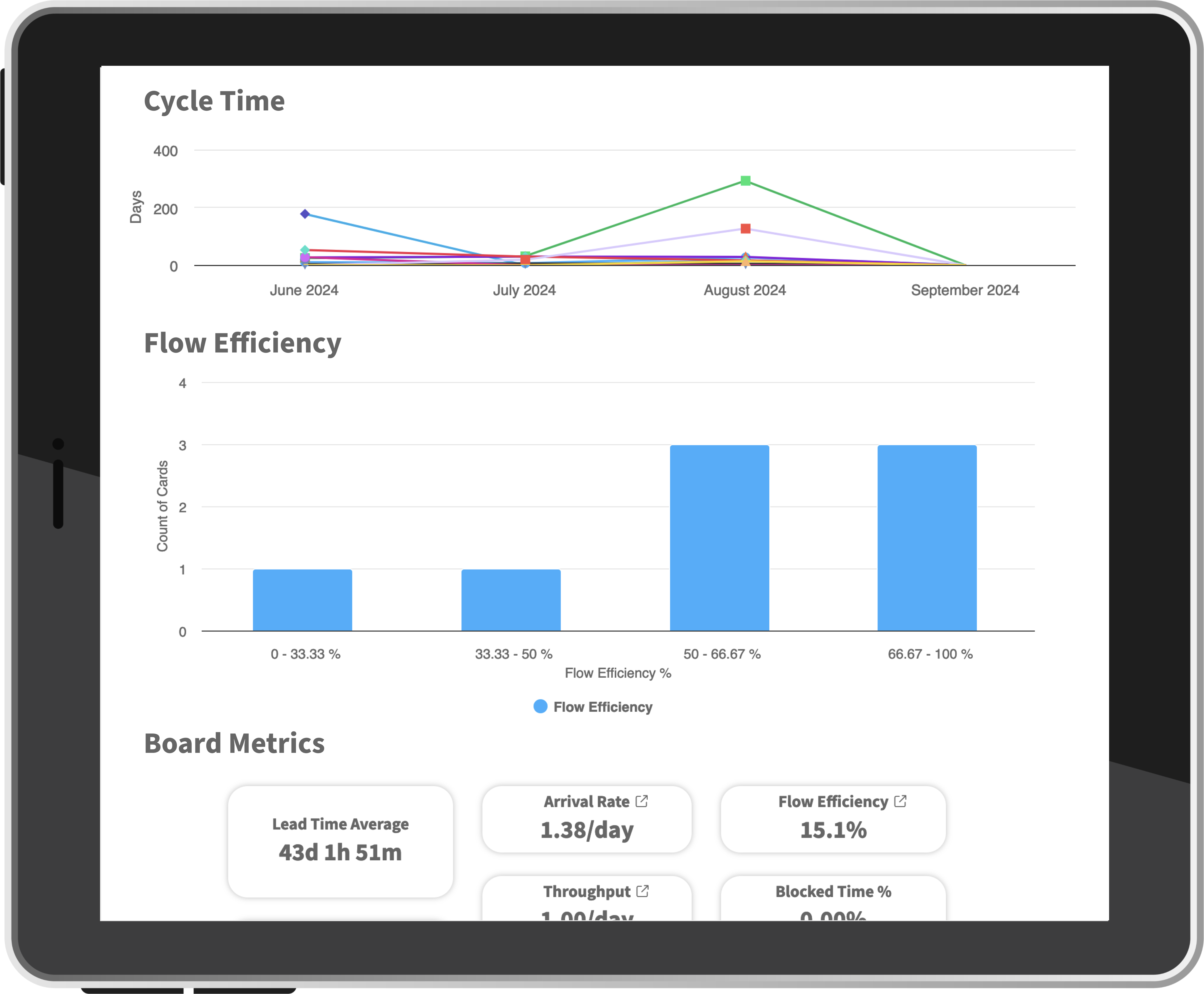
The Essential Kanban Metrics
Kanban metrics can give you anything from a high-level overview of your most important process KPIs to a granular performance analysis of your workflow.
There are three essential Kanban metrics that can be an invaluable ally for your process improvement efforts.
Cycle time
Cycle time is the amount of time it takes to complete a single task or process from the moment it starts until it’s finished. It’s an essential metric in Kanban you can leverage in any type of a visual management system.
Measuring and tracking cycle time is valuable because it helps you identify how quickly work is being completed, which highlights areas for improvement and efficiency optimization.
By reducing cycle time, you can deliver products or services faster, respond more quickly to customer needs, and increase overall productivity, leading to better customer satisfaction and potentially higher profits.
Throughput
Throughput is the number of tasks or orders you complete in a specific period, such as a day or week. Out of all Kanban metrics, this is the most universally applicable.
Throughput is an essential metric because it shows how much work is getting done and helps in understanding the team’s productivity. By tracking and improving throughput, you can handle more tasks in the same amount of time, leading to increased capacity, faster delivery, and potentially higher revenue.
Flow efficiency
Flow efficiency measures the ratio of actual working time to the total time a task spends in the workflow, including waiting times.
It’s invaluable because it reveals how much of the process is productive versus idle, helping identify bottlenecks and delays.
By improving flow efficiency, you can reduce process waste, speed up your workflow, and deliver products or services more quickly, enhancing overall performance and customer satisfaction.
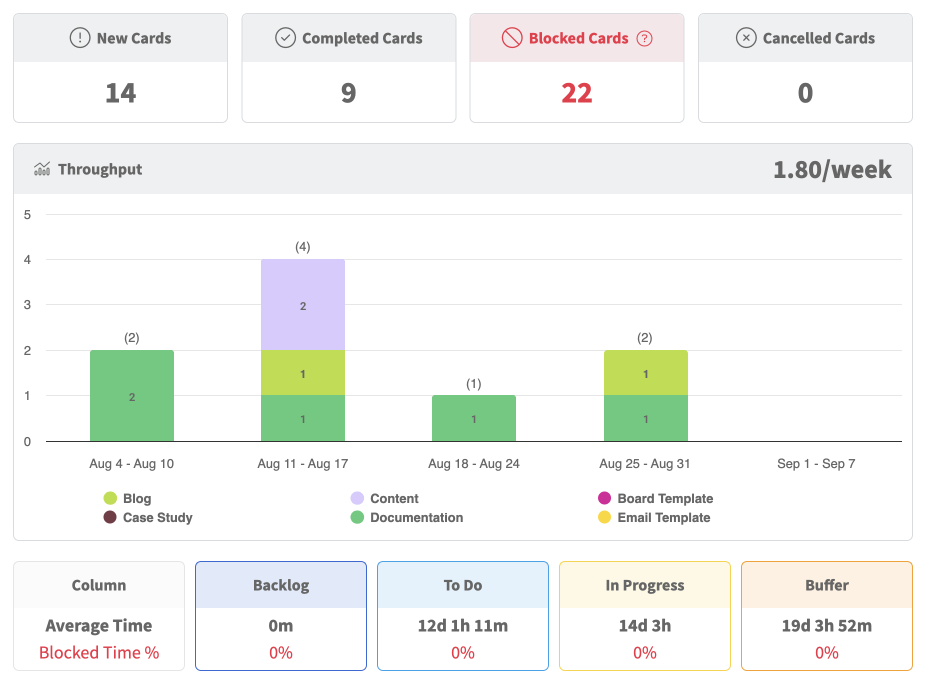
Track All Metrics at the Same Place
Kanban metrics were originally developed to support the effective implementation of the Kanban method.
In time, they proved their value for improving various visual management systems built on Kanban boards as foundation.
We understand that visual management has many forms and dimensions. That’s why, our metrics area is an absolute playground for teams to truly slice and dice their data, in order to help their organizations make better decisions based on actual data.
Kanban metrics were originally developed to support the effective implementation of the Kanban method.
In time, they proved their value for improving various visual management systems built on Kanban boards as foundation.
We understand that visual management has many forms and dimensions. That’s why, our metrics area is an absolute playground for teams to truly slice and dice their data, in order to help their organizations make better decisions based on actual data.
As shown in the screenshot on the right, you can have the most important Kanban metrics at the same place. This provides a quick glance at your performance for the last 4 weeks. However, that’s just the tip of the iceberg.
For a deeper dive in the data, just click on any of the metrics and you’ll experience a whole new world of granularity allowing you to build custom reports containing the data that truly matters to your organization.
You can learn more about the reports available in Kanban Zone in the list below. Unlike many other tools that require additional plugins to access advanced analytics, you can rely on accurate data without all the complications of maintaining any integrations. Our Kanban metrics can help you quickly visualize your work and identify opportunities for improvement.
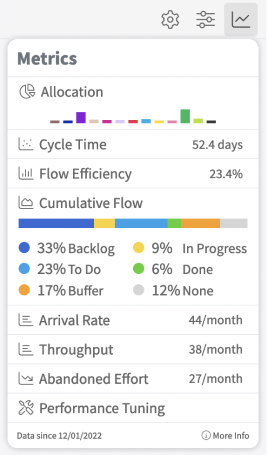
See it in action
Enjoy this short video that will illustrate our Kanban metrics for different use cases and take a deep dive into our Performance Tuning report.
Performance Tuning
This stand-alone report provides a single view to analyze multiple aspects of your team/process.
- Performance Tuning – to identify your bottlenecks, see multiple key performance metrics and understand your lead/cycle time to compare how long it took from the perspective of your customers vs how long it took internally to do the work
Streamline
These Kanban metrics will help you improve the way you balance and flow your work so that you can make your organization or system more efficient and effective.
- Allocation – to better balance the work being worked on by your team or process
- Flow – also known as a Cumulative Flow Diagram (CFD) to track how your work progresses over time by grouping it by the key stages of your process
- Flow Efficiency – to get your flow efficiency score and see which cards had a good flow vs the ones that didn’t
Response Time
These Kanban metrics will help you understand how long it truly takes you to complete work so that you can track how you improve your delivery of work over time.
- Cycle Time – to track how long it takes for your work to get completed in order to determine the responsiveness of your team or process
- Time Distribution – to forecast how much time it takes to complete work based on your past results
Productivity
These reports will let you know exactly how much work you receive and complete so that you can adjust your resources to increase your productivity.
- Arrival Rate – to track how much work you are receiving so that you can better understand your upcoming pipeline of work and set better expectations
- Throughput – to track how much work you are completing so that you can set better expectations by declaring your true team or process capacity
- Created vs Done – to see if your team or process is completing more or less work than they receive within a specific time period
- Abandoned Effort – to track your wasted effort based on how many cards you started but abandoned prior to completing these
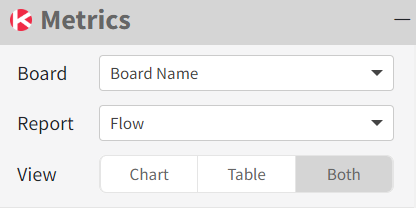
Metrics Selections
Our Kanban metrics area provides the ability to select a specific board within your organization, switch between reports and choose to only see a graph or a table, or both. Some graphs provide multiple options to display the graph. The table shows all the data related to the information shown on the graph. These tables function like our Table zone by providing extremely customizable ways to interact with your data, group, sort, filter, export, and even create more specific charts.
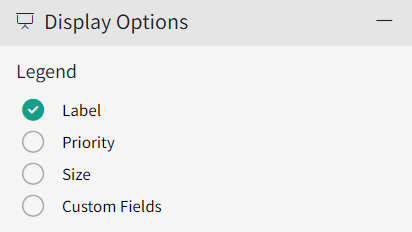
Display Options
Some reports have the ability to select the way you want to display your information by selecting the legend that will show next to the chart. The first three options are standard fields on cards (label, priority, size) and the last option provides the ability to leverage your custom fields.
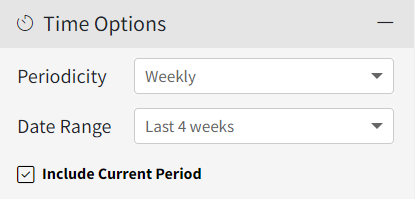
Time Options
Some reports have the ability to select a specific periodicity (daily, weekly, monthly, quarterly) and a customizable date range. You also get the choice to include the current period or not.

Board Filters
Some reports have the ability to select specific column states (backlog, to do, in progress, buffer, done, and none) and within each of these column states, you can also select specific columns. This gives you full control over the data to be included in your report. The cycle time report is one of the Kanban metrics that highly benefits from these board filters, as it lets you target exactly which columns you want to include in your cycle time.
We also offer the ability to include archived cards, as these are no longer shown on the visual management board but could hold helpful data for your analysis. For some of you who have made significant modifications to your boards, you might want to include deleted column information., so we provide this option if applicable to your situation.

Card Filters
Some reports have the ability to filter the data displayed on the chart based on specific card filters. The card owner filter is very helpful to target the contributions of specific members. The card labels are a very important aspect of any board you crate in Kanban Zone, as these serve as your main way to categorize the work that flows on your board. Lastly, you can select any of your custom fields to truly dive deeper into your data.
Set Your Visual Management System Up in Kanban Zone within Minutes
So much power at your fingertips! Get it right away!
Kanban Zone is fully equipped with Kanban metrics you can leverage in any visual management system. Paired with our flexible Kanban board designer, you can build whatever workflow you can imagine and measure performance every step of the way.
You don’t even have to start from scratch. Our platform comes with dozens of customizable templates for different use cases and the ability to import projects from other platforms like Trello and Jira.
Give it a free go! Start your trial account today and find limitless opportunities for working in a more effective and time-efficient way.


Already Using a Collaboration Solution?
Seamlessly migrate your data to Kanban Zone. Our team of experts will ensure a smooth transition and assist you every step of the way. We can assess your current setup, design your ideal system and help you migrate your work.
See for yourself why it’s worth the switch.



